Tuned City interview for Digicult.it
Posted in Text on July 26th, 2008 by admin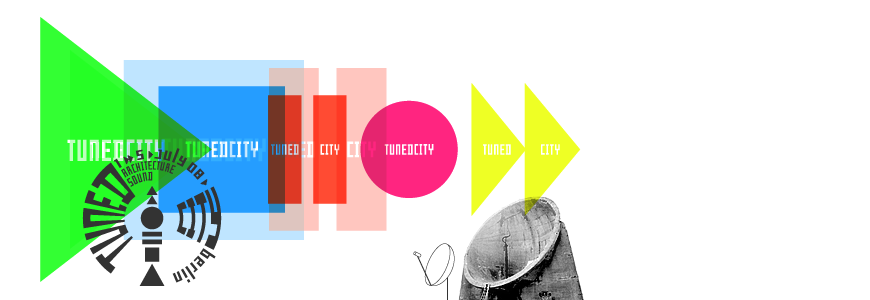
So, next week more than a year of planning finally come together in the Tuned City event, which runs from 1-5 July in Berlin. I helped organize a large chunk of the performance program, along with Carsten Stabenow and Gesine Pagels from the Garage Festival and Carsten Seiffarth, of Tesla Berlin and the Singuhr sound art gallery. Also on board are Anne Kockelkorn of Achplus Magazine and Anke Eckardt as our tireless production director.
The program is simply massive, and covers all sorts of ground between the fields of sound art, acoustics, urban planning and architecture. To see more, please visit the website:
Digicult.it magazine will send Bertram Niessen to cover the event, and he sent a few questions ahead of his visit to help set the stage for his writing.
Bertram Niessen: Can you tell us more about the artists that you have invited? How have you selected the artists that will take part in the events?
Derek Holzer: There are more than 50 artists involved in the Tuned City program, either in creating installations or giving performances, presentations or workshops. It would be very difficult to describe each one, and the process by which we arrived at the decision to invite them! But since I’m responsible for most of the performance program, I can speak about that area the best.
When we started considering works being made relating sound and architecture together, and especially once we started to receive submissions of works from artists, we started to notice that many fit together into certain groups–certain approaches towards sound and space which were common to many of them. You have the artists that want to play tones or noise into a space and play with the acoustic reflections or reverb of the space. Then you have the ones who want to activate objects or structures in the space to produce sound. The field recording approach is also quite common: to make recordings of one space and play it back in another. And finally you have works in the public sphere… provocations, interventions or subliminal messages placed in city streets, squares or tunnels. So based on our own experiences with the artists whose work we know and those we have worked with personally, as well as some of those who sent proposals to the open call, we started to select outstanding examples from each of these categories.
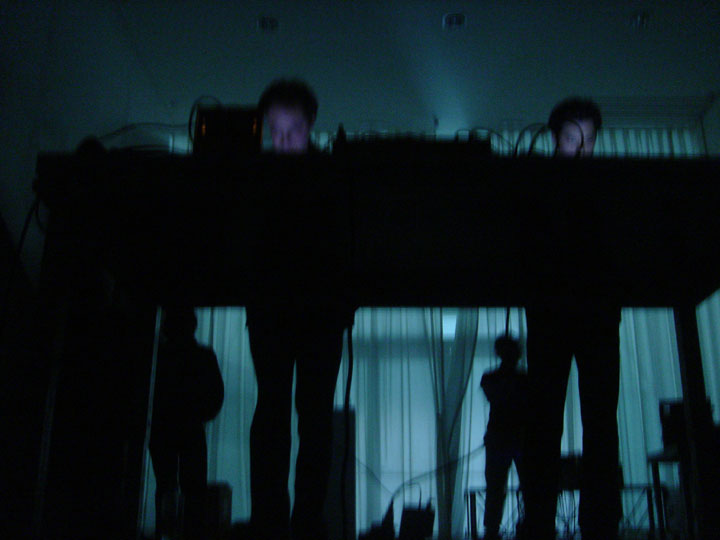
Infrasound – Scott Arford and Randy Yau
The opening night features Scott Arford and Randy Yau, two Americans who have been working in the field of sound art, performance and noise for a long time. I’m quite excited to have the chance to invite them, since I’ve been hearing about them in certain circles for many years now. Their “Infrasound” work is perhaps one of the most powerful examples of the idea of filling a space with pure sound and making a intense physical effect. I’m personally very interested in sound works which affect the body, and that focus on this physicality, rather than being merely cerebral or “clever”. The Dutch duo BMB con. (Roelf Toxopeus and Justin Bennett) will also stage an improvised action that evening. Their work is consistently unpredictable, and they approach each location and setting they perform in with the same energy and humor.
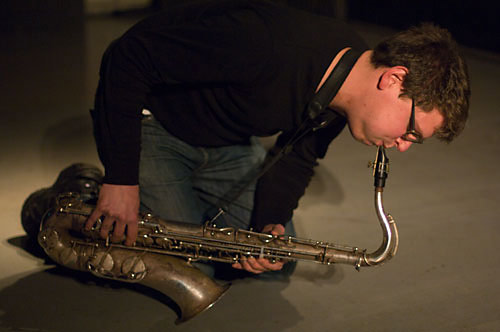
Antoine Chessex
Thomas Ankersmit and Antoine Chessex are two of my personal favorite artists working currently in Berlin. Both play saxophone in very similar and quite different ways, often using circular breathing techniques which extend their playing into almost endless tones. Often, their live solo performances rely on powerful amplification and electronics, however for Tuned City we asked them to present their recently-formed acoustic duo. This performance will take place at the Funkhaus Nalepastrasse, the old East German radio recording studios, and they will acoustically examine various rooms in the hall, from the small instrumental recording rooms to the massive orchestra hall, and use their saxophone drones to map out the resonances and reflections of the building.

Bucky Media – Farmers Manual
We strongly felt that works which operate in the public sphere were very important, and the day we have scheduled for Alexanderplatz (the central square of old East Berlin) gave an excellent opportunity to explore different ways of working this way. We approached German software musician Antye Greie (better known as AGF) with the idea of performing over the public address system of the new Alexa shopping mall, and she was delighted with the idea! Her electronic music has always been filled with spoken texts, many of which relate to the experience of growing up in the East Germany and the shock of the arrival of Western capitalism. So we couldn’t imagine a more ideal setting. Also on this day, the art-hacker group Farmers Manual will present their “Bucky Media” project: two 8 meter high metal-frame spheres, which respond to the audience’s moving them around. Architects love (or hate!) Buckminster Fuller, and the sight of these massive metal balls getting rolled around a public square and emitting these insane noises should really make a big impression on them! Also on that day, UK “electromystic” Martin Howse will conduct an electronic seance near the former site of the Palais der Republik, a Communist-era building for culture which was recently demolished. He will drill through the pavement and pound long rods into the earth, tapping them with an amplifier and a speaker in an attempt to hear what the architectural ghosts of the Palais might have to say.
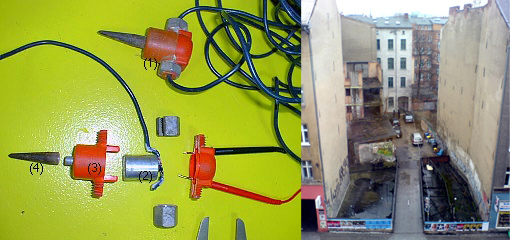
BUG – Mark Bain
Another artist with a history of powerful, physical works with sound and space is Mark Bain. We invited him already for the preview event last February at Club Transmediale, and during that week he negotiated with architect Arno Brandlhuber and the firm b&k architects to make a permanent installation in a new building of theirs. This project, BUG, references the old East German Stasi surveillance techniques on an architectural scale. Bain will place geological sensors in the foundations of the building, and provide headphone jacks in each room so that occupants can listen in to the sounds of the building, whether that be footsteps, mechanical noise or the sound of cars passing in the street or the UBahn which runs directly underneath the building. And on a smaller scale, Will Schrimshaw will use his “Little Helpers”, small microprocessor-controlled motors, to resonate objects and structures in the various event locations, acting like a kind of sonic signpost guiding the way to the performances and symposiums taking place.
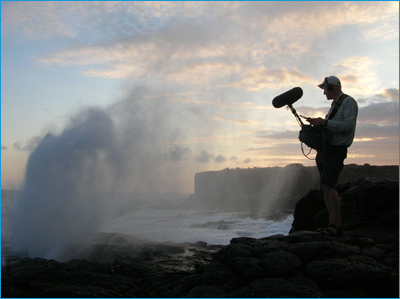
Storm – Chris Watson & BJ Nilsen
Naturally, the area of field recording is well-represented. We asked Rinus van Alebeek if he would like to organize an edition of his Berlin institution Das Kleine Field Recordings Festival, which he has been running almost monthly with no budget to speak of for three years now. This will take place outdoors, at a disused train station which is being renovated from urban wasteland into a park. And for the closing night, legendary field-recordist, BBC soundman and former Cabaret Voltaire member Chris Watson will give a live performance with BJ Nilsen of their “Storm” project, which takes field recordings of powerful storms from Britain and Sweden and spatializes them through the big concert hall of the Nalepastrasse. We also invited Chris Watson to give a workshop, where the participants will explore the day and night time sounds of the city of Berlin with him, and present a multichannel installation of their work at the end. And finally, Estonian-based American sound artist John Grzinich will screen his “Sound Films” as a running installation. Grzinich has recorded countless hours of sound explorations in Estonia, Latvia and Portugal to a video camera, and the often static visual settings where the sounds take place are often contrasted by a very active sonic environment picked up by sensitive microphones, hopefully encouraging people to listen more closely to their own environments.
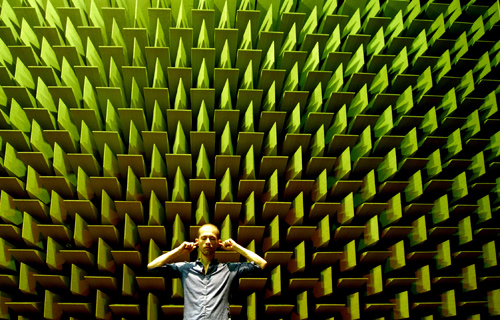
Jacob Kirkegaard
Perhaps the artist whose work for Tuned City least fits into our preconceived categories is Jacob Kirkegaard. His “Labyrinthitis” piece works with tones generated by his own ears during a medical examination, and which can produce a sympathetic resonance in the ears of the audience. I’ve always been interested in the architecture of the body as well, and this piece highlights the role of the listener in the production of sound, taking them from a passive position into a very active state where the sound they hear is in fact coming from themselves.
Of course there are many more artists, performances and installations in the program, as a quick glance at the program on the website or in the catalog shows!
Bertram Niessen: In the festival, several different spaces are involved. How and why have you made this selection?
Derek Holzer: This is really my own take on it, but it’s all too common for academic conferences to discuss things without having any genuine connection to the things they are discussing. Perhaps it’s in the name of “scientific objectivity”, but Brazilian rainforests get discussed in London or New York, punk or noise music gets discussed by elbow-patched professors who have never been to an underground concert in their life, open source software gets discussed in Microsoft Word and Powerpoint files, and architecture gets discussed in boring little white classrooms with ugly fluorescent lights and bad acoustics. So we really wanted to “break down the conventional conference format” by staging the lectures and performances in the kinds of spaces that architects really work in and on: construction sites, renovated buildings, urban wastelands, public squares and buildings which were designed for specific acoustic features and purposes.
Some of the locations suggested themselves out of certain needs, such as the anechoic and echo chambers at the Technical University, or out of specific organizations interested in hosting specific works, such as the installation at the Hamburger Bahnhof Museum garden, the works commissioned by the Singuhr soundart gallery for the Prenzlauerberg Wasserspeicher or the building which Mark Bain will wire up with sensors and microphones.

Fehrnseturm – Alexanderplatz
But the decision to use several of the locations was quite deliberate, based on what we wanted to discuss during each day. So the topics of discussion on the day we occupy Alexanderplatz will center around questions of working in public space, urban space and sonic experience and sound as a system of social communication. Likewise, the next day in the disused Wriezener Bahnhof train station, where tx architects are working with local residents to design a city park which responds to their needs and interests, will focus on the design of acoustic environments.
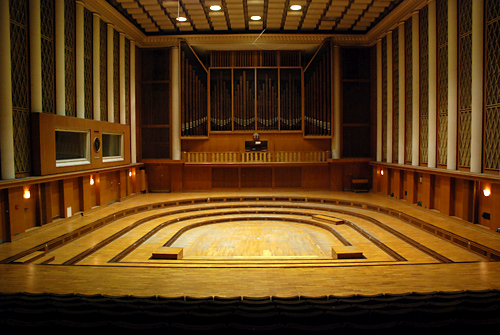
Main concert hall, Funkhaus Nalepastrasse
Perhaps the most astonishing architectural work featured in the event is the Funkhaus Nalepastrasse. This building was designed and built in the 1960’s as home for the East German radio, and two full concert halls (one small, one massive) form the core of this building. The rest of the structure was engineered around these halls as a kind of acoustic buffer, to prevent outside noise from trains or airplanes, for example, from getting in, and every aspect of the interior design, right down to the decorations on the wall panels, was calculated for its effect to absorb, reflect or diffuse sound.
One of the things we encountered quite often when speaking with architects about this project, was that architects are highly visually-oriented, and not very well educated about sound and acoustics, preferring to leave this particular “pain in the ass” to the acousticians, who come to clean up the mess with panels and such, later on. So to situate our final day in a building whose entire purpose was to sound good and to produce good sound, is a powerful statement that acoustic design should not be relegated to a secondary role, but rather should be an integral part of the architectural process from the beginning.
